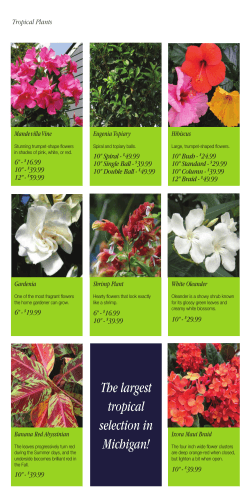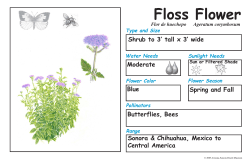
in Japan - Ikebana Singapore
No 2 Mar - Jun 2015 Winter/Spring in Japan Photography by Viola Yong© HAGOITA PADDLES In Japan, New Year celebrated on January 1st with many traditions that include decorating the house with pine and bamboo, visiting the shrines and eating mochi and osechi to cheer in the good luck. Hagoita, or paddle dolls are also associated with the New Year. They are decorated paddles, traditionally given as New Year’s gifts to girls. Like badminton, the game of hanetsuke is played with these paddles and a feathered large seed for a shuttlecock. The Hagoita is usually rectangular in shape. When playing “Hanetsuke”, since the Hagoita’s movement is similar to the “Harau” action (a Japanese expression meaning “drive away”), it is thought to be effective to drive away evil spirits and is thus often used as a charm against evil. Over the years, these paddles have become collector’s item as the other side of the paddle is usually decorated with elaborate padded cloth faces of geishas or kabuki actors using an art form called “oshie” or “padded painting”. The “Oshie” drawings are usually created with washi paper or cloth cut out in the shape of flowers and people, and then pasted onto the paddle with cottons inside them to give them a three dimensional aspect. Every year for last 350 years, in December, a hagoita market is held on grounds of Senso-ji temple in Akasuka which sells nothing but these paddles. Traditionally, the old year’s paddles are supposed to be burned at the end of the year, but nowadays people collect these for their beauty and uniqueness. HANAMI The mild weather, the myriad shades of budding greenery, the riot of flowers and the accompanying hanami culture makes Japan a much loved destination during spring. Hanami or ‘flower viewing’ is a very old tradition in Japan. Though hanami can be the viewing of any flower, over the centuries it has become synonymous with viewing the famous sakura or cherry blossoms and experiencing the charm of the unfolding of the Japanese spring. The sakura or cherry blossom is the unofficial national flower of Japan. The magic of the sakura bloom in the beginning of spring is the harbinger of warm and sunny days. In reality, the plum (or ume), the humble cousin of cherry blossom, begins to bloom much ahead of cherry trees and this is in fact the true messenger of forthcoming spring. However, the cherry blossom has created its own special place in the heart of the Japanese because of the accompanying hanami culture. Around late March or early April, when the warm spring wind flows from the south, Tokyo and the surrounding areas are engulfed in a wave of beautiful pink and white flowers. More than a hundred varieties of cherry blossoms grow in Japan. The flowers are an array of shades in white, pink and pale yellow and bloom only for 10-14 days. They are found everywhere across Japan, growing wild in the mountains, forests and riversides or planted in parks, private gardens, schools, public buildings, industrial areas and along many major sakura avenues. The fleeting season of sakura and the balmy weather of spring beckon the young and old to stop all work, don spring attire, gather under the sakura trees and hanami. Sakura viewing parties are significant for the Japanese, as they believe that sakura possess an inherent vitality that affects those who gather under the flower laden boughs to drink sake, a traditionally brewed, popular rice wine, and write or recite poetry. PHOTOS OF JAPAN DURING WINTER AND SPRING Photos Courtesy of Viola Yong, Silvana Sutanto and Richard Mock MEMBERSHIP & FRIENDSHIP MEMBER NEWS We are proud to be the first chapter in the world to have the approval of the HQ for our youngest member who is still less than 2 years old. Our veteran member Lilian Ong’s granddaughter is now the youngest ,member in the world of II . Thank you to Lilian and her family for their support over 3 generations. FAREWELL TO MR AND MRS ANDO AND WELCOME MS MISAKO ITO, NEW CULTURAL DIRECTOR OF JCC The Chapter members said good bye to Mr and Mrs Ando at a Lunch in last August. As Head of Japan Creative Centre, Mr Ando and his wife immensely supported the activities of the Chapter for which we will always be grateful. Best wishes to the family as they move to their new posting. Welcome Ms Misako Ito who is appointed as the new cultural Director at Japan Creative Centre. II looks forward to working with Ms Ito and JCC to promote the art of Ikebana EUROPEAN CONVENTION Our member Christiane Duckworth attended the European Convention at Postdam Germany. 96TH ANNIVERSARY OF SOGETSU SCHOOL OF IKEBANA AT TOKYO Our members – Anna Kwan, Linda Soo Tan, Viola Yong and Christopher Lim attended and displayed their arrangements at the 96th Anniversary of Sogetsu School of Ikebana at Tokyo. INTERVIEW ON CHANNEL 8 At the Christmas event, Liti Tandjung, our long term member was interviewed on Channel 8. The interview conducted in Mandarin focused on Principles of Ikebana and our Chapter Activities. http://www.channel8news.sg/mobile8/ca/morningexpress/episodes/20141226-meinterests/1549910.html JAPANESE KAWAI MEMBERSHIP & FRIENDSHIP EUROPEAN CONVENTION, POTSDAM, AUGUST 2014 When it was known that the 8th European Convention was to be held in Potsdam near Berlin it was the chance to fulfil a long held desire to visit the capital of my home country. The hotel where the convention took place was set in a beautiful area just outside Potsdam, a place where German history was made on many different levels. In the evening we were all welcomed at a BBQ in the lovely garden setting of the hotel with views over the River Havel. The highlight for all was surely the the spectacular demonstration by Sogetsu Iemoto Akane Teshigahara. A specially chartered boat took participants through the famous Potsdam lakes to the famous Hans Otto Theatre where the demonstration took place. The Iemoto had everyone enthralled with her artistry. It was particularly fascinating to see how, with the help of many hands, the final large scale design evolved in front of our eyes. Much ‘pruning’ will have been done in the parks of Potsdam. How lucky we are to be part of a worldwide organization where FRIENDSHIP THROUGH FLOWERS gives so many diverse opportunities. At Conferences we have a chance to see different parts of the world, view designs by schools that are not represented in one’s own chapter, meet old friends and make new ones literally all over the world as well as in the home chapter. Article and photos courtesy of Christiane Duckworth 96TH ANNIVERSARY OF SOGETSU SCHOOL OF IKEBANA, TOKYO Encouraged by like-minded friends of Ikebana, I decided to take up the challenge of setting up a solo freestyle exhibition at the 96th Anniversary of Sogetsu School of Ikebana in Tokyo. As an amateur, I planned to bring all materials, including flowers and props to Tokyo. I did not want to take chances as the dried materials and fresh flowers may not be readily available upon arrival. I was proven right, as it was difficult to source for flowers and materials. The setting up was an eye-opener. This was exhibition setting up on a large scale with 180 participants per session over 2 days. Only two hours for the set-up for single participants without any help. Everything executed smoothly like clockwork. No privileges, no concessions to foreigners. The theme for this year was: “Set Things You Cannot See”. It was wide open to interpretation, and the end result was that we saw extreme, weird, controversial arrangements. In one extreme case, there was only a glass vase with water, nothing else. It was like: “Please use your imagination here”. The closest that I came to interpreting the theme was that my vase was almost hidden, so that no one actually see the self-made vase. This was a pity, because the vase was unique, along with some flowers and leaves that were not familiar to the locals. Having seen all the exhibits, I come away feeling that we are at par with the best of them, and that with a bit more effort, we can do a better job next time around. In conclusion, taking part in this exhibition was a great learning experience, and I would recommend to try it at least once in your lifetime! Ultimately, it is also about enjoying what you do, being passionate about your hobby, and sharing the joys of Ikebana with others! Article courtesy of Linda Soo Tan and photos courtesy of Viola Yong UPCOMING EVENTS ANNUAL EXHBITION AT PARAGON April 2-10th 2015 Time : 10 am to 9 pm Open to Public, Free Entry Opening Ceremony: April 2nd 2015 at 6 pm (By invitation only) To Exhibit: Contact Viola Yong, E-mail : [email protected] 13th ASIAN REGIONAL CONFERENCE PHOTO GALLERY PHOTO GALLERY PAST EVENTS IKEBANA INSPIRED BY BABA AND NONYA The Japan Creative Centre located in a black and white house was transformed into a peranakan home complete with furniture, costumes, paintings, beadwork and everyday household items. This was a befitting venue for a unique exhibition, “Ikebana Inspired by Baba Nyonya” showcasing traditional Japanese Ikebana blended with the local Peranakan culture. This was also an occasion to welcome our new members. The ikebana arrangements incorporated local flowers in Peranakan containers from vases, to enamel tiffin, wedding baskets and trays, giving it a unique local flavor. A demonstration by Bernard Tay making use of Peranakan sarongs, utensils, baskets and local material in addition to his interesting commentary made this event very special. Photos courtesy of Angela Kek KL TOUR The spirit of Friendship through flowers could be felt all through our member’s trip to Kuala Lumpur to join our sister Chapter’s Golden Anniversary celebration. The two day event that included setting up of exhibition, attending workshop and demonstration by Ikenobo Prof Junko Kikuchi from London and a gala dinner, proved to be fun and enjoyable and a great networking opportunity. Photos courtesy of Christiane Duckworth CHRISTMAS CELEBRATIONS A white winter day themed Christmas was celebrated in Shangri-La with our members, friends and Guest of Honour Mrs Yoko Hanada, President of Kamakura Chapter. Award winning floral designer Harijianto Setiawan did 6 exquisite floral arrangements capturing winter day scenes and holiday mood using country flowers and unusual materials like cinnamon sticks, airplants and berries. CHINESE NEW YEAR Chinese New Year goodies, Calligraphy, festive food, God of Fortune and customary tossing of the Yusheng all came together as we ushered in the Year of the Goat - an Intelligent, Creative and Dependable animal. At the luncheon themed “Mandarin Blossoms” The demonstrators – Christopher Lim and Shirley Cheah of Sogetsu School used auspicious material of the new year to create large sized arrangements for the viewing pleasure of all. Mrs Takeuchi, wife of Ambassador of Japan to Singapore was the Guest of honour at this fun filled event. CALENDAR 2015 Election (Tentative) Ikebana International Singapore 135 is a non-profit cultural organisation with headquarters in Tokyo, Japan Website : www.ikebanasingapore.org Mailing Address : Tanglin P.O. Box 26 Singapore 912401 Photography by Silvana Sutanto©
© Copyright 2025










